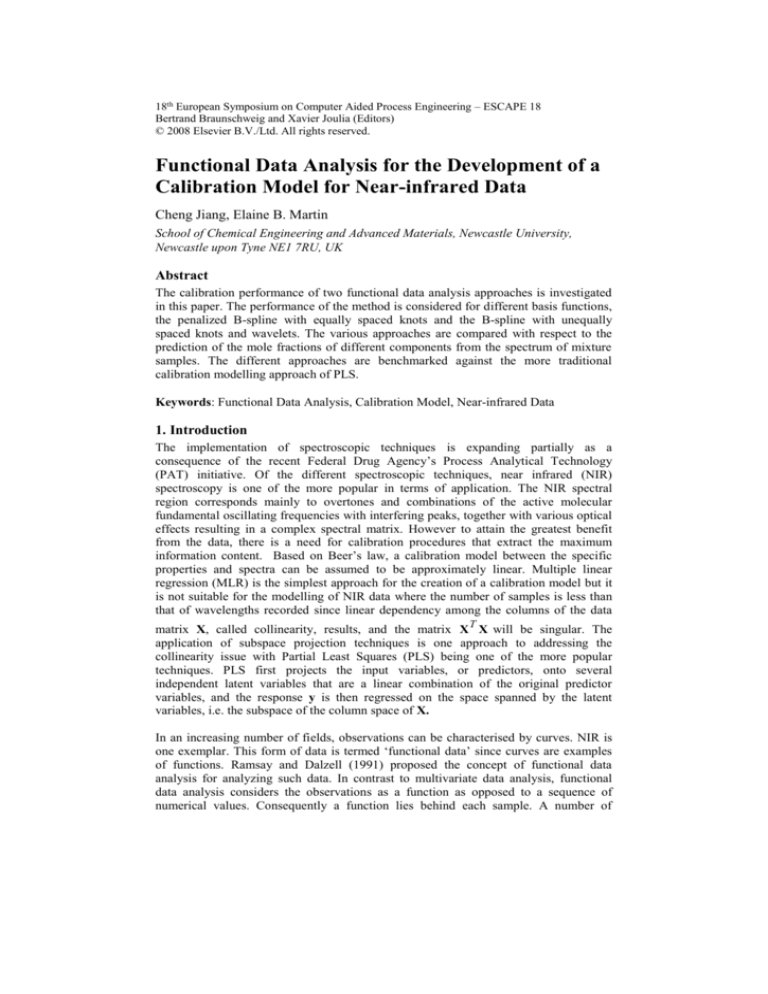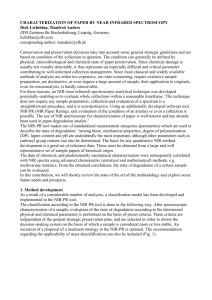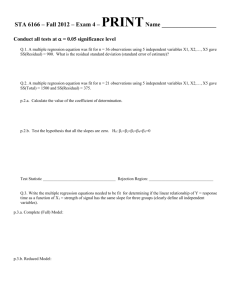
18th European Symposium on Computer Aided Process Engineering – ESCAPE 18
Bertrand Braunschweig and Xavier Joulia (Editors)
© 2008 Elsevier B.V./Ltd. All rights reserved.
Functional Data Analysis for the Development of a
Calibration Model for Near-infrared Data
Cheng Jiang, Elaine B. Martin
School of Chemical Engineering and Advanced Materials, Newcastle University,
Newcastle upon Tyne NE1 7RU, UK
Abstract
The calibration performance of two functional data analysis approaches is investigated
in this paper. The performance of the method is considered for different basis functions,
the penalized B-spline with equally spaced knots and the B-spline with unequally
spaced knots and wavelets. The various approaches are compared with respect to the
prediction of the mole fractions of different components from the spectrum of mixture
samples. The different approaches are benchmarked against the more traditional
calibration modelling approach of PLS.
Keywords: Functional Data Analysis, Calibration Model, Near-infrared Data
1. Introduction
The implementation of spectroscopic techniques is expanding partially as a
consequence of the recent Federal Drug Agency’s Process Analytical Technology
(PAT) initiative. Of the different spectroscopic techniques, near infrared (NIR)
spectroscopy is one of the more popular in terms of application. The NIR spectral
region corresponds mainly to overtones and combinations of the active molecular
fundamental oscillating frequencies with interfering peaks, together with various optical
effects resulting in a complex spectral matrix. However to attain the greatest benefit
from the data, there is a need for calibration procedures that extract the maximum
information content. Based on Beer’s law, a calibration model between the specific
properties and spectra can be assumed to be approximately linear. Multiple linear
regression (MLR) is the simplest approach for the creation of a calibration model but it
is not suitable for the modelling of NIR data where the number of samples is less than
that of wavelengths recorded since linear dependency among the columns of the data
matrix X, called collinearity, results, and the matrix X T X will be singular. The
application of subspace projection techniques is one approach to addressing the
collinearity issue with Partial Least Squares (PLS) being one of the more popular
techniques. PLS first projects the input variables, or predictors, onto several
independent latent variables that are a linear combination of the original predictor
variables, and the response y is then regressed on the space spanned by the latent
variables, i.e. the subspace of the column space of X.
In an increasing number of fields, observations can be characterised by curves. NIR is
one exemplar. This form of data is termed ‘functional data’ since curves are examples
of functions. Ramsay and Dalzell (1991) proposed the concept of functional data
analysis for analyzing such data. In contrast to multivariate data analysis, functional
data analysis considers the observations as a function as opposed to a sequence of
numerical values. Consequently a function lies behind each sample. A number of
2
C. Jiang and E. Martin.
applications of FDA have been reported including in the areas of economics, medicine,
biology and chemometrics.
As NIR spectra can be considered as functional data, it is hypothesised that functional
data analysis can capture the inherent structure of NIR spectra and hence FDA may
provide an alternative approach to constructing a calibration model. Two functional
linear regression approaches are discussed in this paper and are benchmarked against
the more traditional approach of PLS. The arrangement of this paper is as follows.
Section 2 introduces the different FDA approaches with details of the data set used in
the study described in section 3. The results and a discussion of them is presented in
section 4 with overarching conclusions provided in the final section.
2. Functional Linear Regression Approaches
Functional data analysis is a new way of thinking. The underlying philosophy behind it
is that the item (sample) on which the functional data analysis is performed is
considered as a function as opposed to a series of discrete data points. Based on this
definition, with respect to the calibration analysis of NIR data, the NIR spectrum is
considered as a function with the response being a specific property of an analyte. The
goal of calibration is to build a model between a functional predictor and a scalar
~
1
response. Consequently there exists a linear operator L between R and R such that
it maps a function lying in R to a scalar lying in R 1 :
~
(1)
L : R R1
Thus the relationship between the NIR spectrum and the specific property is represented
~
~
by the linear operator L . Two approaches for estimating the operator L are discussed
in this paper. One approach is fitting the NIR spectra with mathematical basis functions
and then developing regression model between the response variables and the fitting
coefficients. The second approach represents the regression coefficients by basis
functions as opposed to the original spectra. Both approaches utilize the functional
properties of NIR spectra. The first approach assumes the shape information contained
within NIR spectra can be captured by the basis functions and the second hypothesis
that the curve information of the NIR spectra can be reflected by that of the regression
coefficients. A mathematical framework for these approaches is now presented.
2.1. Indirect Approach
Although the individual spectrum is a point in the R space, the dimension of variation
between the N samples is always finite. Thus it can be assumed that the N spectra
samples lie in the space spanned by a set of finite mathematical basis functions. Let the
functional format of the whole spectrum be x( ) , where denotes the wavelength.
1( ), 2 ( ), ,k ( ) indicates the set of basis functions and x( ) is represented by a
linear combination in terms of the k basis functions
k
x( ) cii ( ) ( )
i 1
(2)
Here ( ) represents noise and c1,, ck are the fitting coefficients. Since
1( ), 2 ( ), ,k ( ) are mathematically independent, c1, c2 ,ck are unique.
Consequently according to the property of linear operators:
Functional Data Analysis for the Development of a Calibration Model for
Near-infrared Data
~
~
~
~
(3)
y L x( ) c1L 1 ( ) c2 L 2 ( ) ck L k ( )
~
Therefore, L x( ) can be calculated from Eq. (3) as a linear combination of
~
~
~
L 1( ),, L k ( ) , as opposed to estimating the operator L directly. Eqs. (2) and (3)
can be expressed in matrix notation as:
X CΦ E X
(4)
where the elements of Φ are the basis functions 1 ( ), 2 ( ), ,k ( ) , C is the fitting
coefficient matrix and E X is that part of X unexplained by basis functions.
y CL e
(5)
~
~
where the elements of L are L 1 ( ),, L k ( ) and e is a noise term. Typically, the
number of samples (spectra) is less than the number of fitting coefficients. In this
situation, classical regression methods cannot be applied directly. Consequently,
different strategies need to be considered to address this problem. Two approaches
discussed in this paper are: (i) apply PLS to build a regression model between the
response variable and the fitting coefficients, and (ii) place a hard constraint on the
number of basis functions such that ordinary least squares can be applied.
2.2. Direct Approach
~
In the case that the predictor is a function and the response is a scalar, the operator L
can be considered as an inner product operator and the estimation of the response is the
inner product of the functional predictor and the regression coefficient. For example, let
the matrix notation for the relationship between the response y and the predictor X be
y Xb e . Xb is scalar since y is a scalar, consequently, Xb can be considered as
the inner product of X and b , hence b should be a function since X is a function
y
n
x( )b( )d x, b e
(6)
0
where 0 , n denotes the range of the spectrum, and <,> denotes the inner product. The
problem now becomes how to estimate the function b( ) . The approach discussed in
this paper is to represent the regression coefficient b by a set basis functions directly as
opposed to the original spectrum. Let b( ) be represented by m basis functions:
m
b( ) cvv ( )
(7)
v 1
Thus x, b can be calculated as:
x, b
n
m
m
n
0
v 1
v 1
0
x( ) ( cvv ( ))d c v x( )v ( )d
(8)
c1,, cm are the parameters to be estimated. The matrix notation for Eqs (7) and (8) is:
y XΦT c e
(9)
The framework was based on Penalized Signal Regression (PSR) with penalized Bsplines representing the regression coefficient (Marx and Eilers, 1999).
4
C. Jiang and E. Martin.
However the choice of basis functions is an issue in FDA. Ideally basis functions should
have some features matching those of the estimated functions. Considering the nonperiodic and broad bands combinational shape feature of NIR spectra, three
mathematical basis functions considered were penalized B-spline with equally spaced
knots, the B-spline with unequally spaced knots and wavelets.
2.3. Basis Functions and Fitting Methods
2.3.1. Penalized B-Spline
Splines are the most common basis function for non-periodic curve approximation, as
they can accommodate local features. The B-spline developed by de Boor is the most
popular for constructing spline bases. Suppose that the spectrum x( ) is defined over a
closed interval T [0 , n ] that is then divided into k+1 subintervals by k internal knots
( i k : 1 , 2 , , k ), such that 0 1 2 k n . If the B-spline has a
fixed degree d, it has continuous derivatives of degree up to d 1 , and the total number
of spline bases is k n k d 2 . When using the B-spline as a smoother, the issue is
how to choose the number and position of knots to avoid over or under fitting. Eilers
and Marx (1996) proposed using a relatively large number of equi-spaced knots and a
penalty on the finite differences of the coefficients of adjacent B-spline to avoid
overfitting. This approach was termed the “P-spline”, penalized B-spline. The fitting
criterion based on least squares using the penalized B-spline is given by:
p
K
SMSSE( x c) [ x j ck B j , K 2 1 ( x j )] 2
j 1
k 1
K
(
m
k m 1
ck ) 2
(12)
where is a parameter for controlling the smoothness of the fit, m is the difference
operator, which is defined as:
1ck ck ck 1
(13)
2 ck 1 (1ck ) 1 (ck ck 1 ) 1ck 1ck 1 ck 2ck 1 ck 2
(14)
When using a P-spline, four parameters require to be chosen: spline degree d, knot
number k, differences degree m and .
2.3.2. Free knots B-Spline
This approach, based on a Bayesian approach, automatically identifies the optimal
number and location of the internal knots. The fitting method adopted in this paper was
proposed by Dimatteo, et al. (2001). First, a cubic B-spline is assumed. And a
reversible-jump Markov chain Monte Carlo (MCMC) (Green. 1995) is implemented to
change the knot number k and location (1, 2 ,, k ) . Finally, a posterior
distribution of the knot number and location is achieved.
2.3.3. Wavelets
The fundamental idea of wavelets is multiresolution analysis. The ‘mother wavelet’
plays a primary role in wavelet analysis. Once a wavelet is chosen, a functional datum
x( )
can
be
decomposed
into
different
wavelet
components
jk ( ) 2 j / 2 (2 j k ) , with the dilation and translation of the ‘mother wavelet’
forming a set of basis functions that capture features in the frequency and time domain.
Functional Data Analysis for the Development of a Calibration Model for
Near-infrared Data
The wavelets considered are Daubechies wavelets and are classified in terms of the
number of vanishing moments. The first and third Daubechies wavelets are considered
Table 1. Prediction results
Method
PLS
Indirect
Approach
P-spline with PLS
P-spline with limit
numbers
Free knots
B-spline with PLS
Daubechies
wavelets(first)with
PLS
Daubechies
wavelets(third)
with PLS
Direct
Approach
PSR
Daubechies
wavelets(first)
Daubechies
wavelets(third)
Temp(ºC)
30
40
50
60
70
30
40
50
60
70
30
40
50
60
70
30
40
50
60
70
30
40
50
60
70
30
40
50
60
70
30
40
50
60
70
30
40
50
60
70
30
40
50
60
70
Ethanol
RMSEP
0.014
0.013
0.038
0.016
0.018
0.016
0.009
0.030
0.013
0.014
0.004
0.007
0.011
0.009
0.014
0.015
0.018
0.048
0.020
0.026
0.016
0.013
0.037
0.018
0.022
0.018
0.011
0.022
0.017
0.021
0.006
0.009
0.016
0.015
0.027
0.003
0.014
0.019
0.014
0.016
0.005
0.013
0.015
0.012
0.016
Water
RMSEP
0.012
0.006
0.008
0.008
0.008
0.011
0.007
0.008
0.008
0.005
0.003
0.003
0.008
0.006
0.005
0.009
0.004
0.008
0.008
0.005
0.014
0.007
0.008
0.009
0.005
0.014
0.004
0.008
0.008
0.005
0.004
0.003
0.008
0.006
0.006
0.004
0.006
0.010
0.005
0.008
0.004
0.006
0.010
0.005
0.008
2-propanol
RMSEP
0.011
0.016
0.041
0.017
0.017
0.012
0.014
0.031
0.015
0.012
0.004
0.006
0.016
0.004
0.010
0.011
0.022
0.053
0.020
0.026
0.013
0.016
0.039
0.021
0.023
0.011
0.008
0.020
0.018
0.024
0.003
0.009
0.024
0.011
0.020
0.003
0.011
0.022
0.011
0.013
0.003
0.010
0.020
0.010
0.014
3. Case Study
A NIR spectral data set is considered (Wülfert et al. (1998)). Spectra of mixtures of
ethonal, water and 2-propanol are used to predict the mole fractions of these
6
C. Jiang and E. Martin.
components. Measurements of 19 samples at five temperatures (30, 40, 50, 60 and 70 ºC)
in the range, 580-1091nm, with 1nm resolution were recorded. Only the spectral region
850-1049 nm was considered in the analysis. The samples were divided into 13 training
and 6 test samples as described in the paper (Wulfert et al. 1998). Features associated
with the spectra included an apparent band shift and broadening which introduced nonlinearity into the relationship between the spectra and reference values. Mean centering
was first applied. The root mean square error of prediction was used as the performance
criteria to evaluate the predictive ability of the different models.
4. Results and Discussion
In this section, the results of applying different functional linear regression approaches
are considered which are benchmarked against PLS. The indirect approach with Pspline, free knots B-spline, and wavelets and the direct approach with P-spline, and
wavelets were applied to the data. The prediction results are given in Table 1. It can be
observed that the performance of PLS and the functional linear methods, especially the
indirect methods with PLS being used for defining the relationship between the
response and fitting coefficients, are comparable. Using a basis functions to fit the data,
i.e. performing a transformation on the original data, variations within the original data
will be transferred to the variation between the fitting coefficients. If a complete
mathematical basis functions (i.e. wavelets) is used, the variation will be nearly totally
transferred, which is the reason that PLS and functional linear methods with wavelets
achieve similar prediction results. The B-spline is not a complete bases hence greater
fitting errors may be introduced to the variations of the fitting coefficients resulting
occasionally in a large prediction bias.
5. Conclusions
The prediction performance of PLS and functional linear regression methods is
comparable except for the indirect method when a hard constraint is placed on the
number of P-spline. For the data set studied it outperforms all other methods. The
rationale for this needs further investigation. Both approaches can be described within a
common framework as the loadings of PLS can be considered as data-based basis
function. Future work is on-going on how to choose basis functions.
Acknowledgements
CJ acknowledges the financial support of the Dorothy Hodgkin Postgraduate Awards.
References
I. Dimatteo, C.R. Genovese and R.E. Kass, 2001, Bayesian curve-fitting with free-knot splines.
Biometrica, 88(4), 1055-1071.
P.J. Green, 1995, Reversible jump Markov Chain Monte Carlo computation and Bayesian model
determination. Biometrica, 82(4), 711-732.
B.D. Marx and P.H. Eilers, 1996, Flexible smoothing with B-splines and penalties (with
comments and rejoinder). Statistical Science, 11(2): 89-121
B.D. Marx and P.H. Eilers, 1999, Generalized linear regression on sampled signals and curves: A
P-spline approach, Technometrics, 41, 1-13.
J.O. Ramsay and C.J. Dalzell, 1991, Some tools for functional data analysis, Journal of the Royal
Statistical Society, Series B, 53, 539-572
F. Wülfert, W.T. Kok and A.K. Smilde, 1998, Influence of temperature on vibrational spectra
and consequences for the predictive ability of multivariate models. Anal Chem.,70, 1761-1767.







